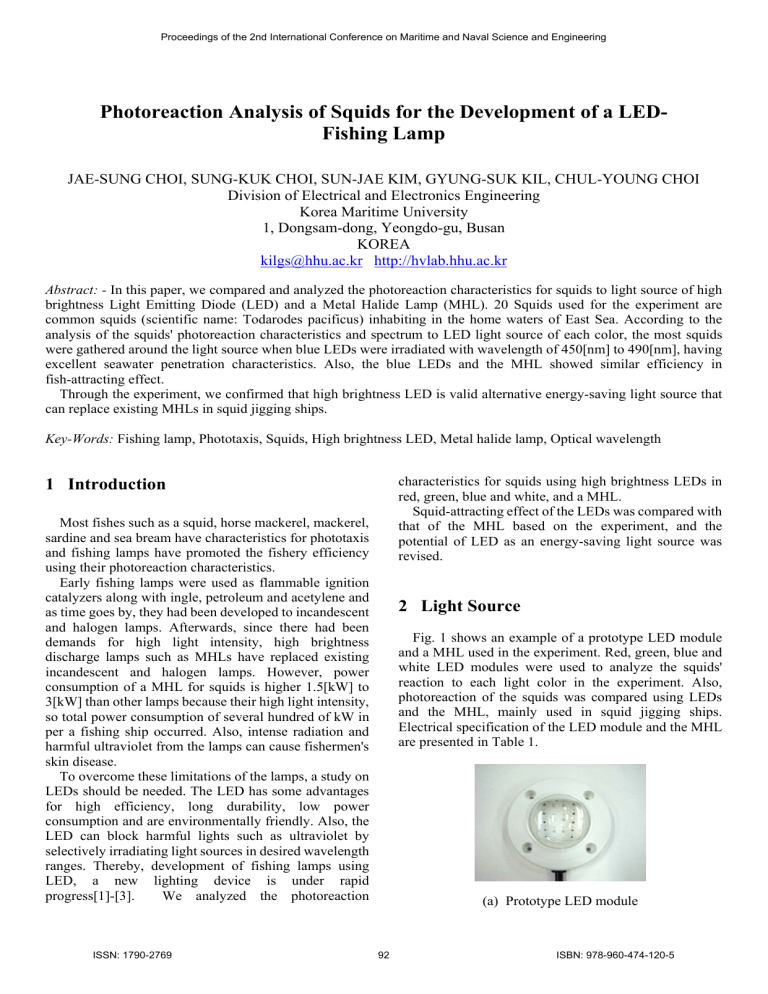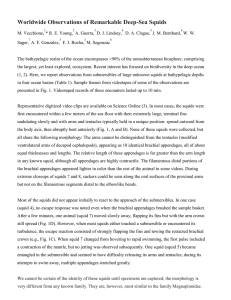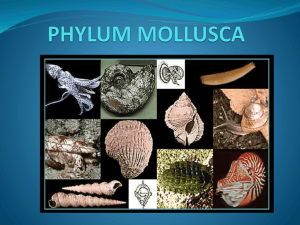Photoreaction Analysis of Squids for the Development of a LED

Proceedings of the 2nd International Conference on Maritime and Naval Science and Engineering
Photoreaction Analysis of Squids for the Development of a LED-
Fishing Lamp
JAE-SUNG CHOI, SUNG-KUK CHOI, SUN-JAE KIM, GYUNG-SUK KIL, CHUL-YOUNG CHOI
Division of Electrical and Electronics Engineering
Korea Maritime University
1, Dongsam-dong, Yeongdo-gu, Busan
KOREA kilgs@hhu.ac.kr
http://hvlab.hhu.ac.kr
Abstract: - In this paper, we compared and analyzed the photoreaction characteristics for squids to light source of high brightness Light Emitting Diode (LED) and a Metal Halide Lamp (MHL). 20 Squids used for the experiment are common squids (scientific name: Todarodes pacificus) inhabiting in the home waters of East Sea. According to the analysis of the squids' photoreaction characteristics and spectrum to LED light source of each color, the most squids were gathered around the light source when blue LEDs were irradiated with wavelength of 450[nm] to 490[nm], having excellent seawater penetration characteristics. Also, the blue LEDs and the MHL showed similar efficiency in fish-attracting effect.
Through the experiment, we confirmed that high brightness LED is valid alternative energy-saving light source that can replace existing MHLs in squid jigging ships.
Key-Words: Fishing lamp, Phototaxis, Squids, High brightness LED, Metal halide lamp, Optical wavelength
1 Introduction
Most fishes such as a squid, horse mackerel, mackerel, sardine and sea bream have characteristics for phototaxis and fishing lamps have promoted the fishery efficiency using their photoreaction characteristics. characteristics for squids using high brightness LEDs in red, green, blue and white, and a MHL.
Squid-attracting effect of the LEDs was compared with that of the MHL based on the experiment, and the potential of LED as an energy-saving light source was revised.
Early fishing lamps were used as flammable ignition catalyzers along with ingle, petroleum and acetylene and as time goes by, they had been developed to incandescent and halogen lamps. Afterwards, since there had been demands for high light intensity, high brightness discharge lamps such as MHLs have replaced existing incandescent and halogen lamps. However, power consumption of a MHL for squids is higher 1.5[kW] to
3[kW] than other lamps because their high light intensity, so total power consumption of several hundred of kW in per a fishing ship occurred. Also, intense radiation and harmful ultraviolet from the lamps can cause fishermen's skin disease.
To overcome these limitations of the lamps, a study on
LEDs should be needed. The LED has some advantages for high efficiency, long durability, low power consumption and are environmentally friendly. Also, the
LED can block harmful lights such as ultraviolet by selectively irradiating light sources in desired wavelength ranges. Thereby, development of fishing lamps using
LED, a new lighting device is under rapid progress[1]-[3]. We analyzed the photoreaction
2 Light Source
Fig. 1 shows an example of a prototype LED module and a MHL used in the experiment. Red, green, blue and white LED modules were used to analyze the squids' reaction to each light color in the experiment. Also, photoreaction of the squids was compared using LEDs and the MHL, mainly used in squid jigging ships.
Electrical specification of the LED module and the MHL are presented in Table 1.
(a) Prototype LED module
ISSN: 1790-2769 92 ISBN: 978-960-474-120-5
Proceedings of the 2nd International Conference on Maritime and Naval Science and Engineering
(b) Metal halide lamp
Fig. 1 Light sources for fishing lamps
Table 1 Electrical specification of the LED and the MHL
Light
Source
Rated
Voltage
Driving
Current
Power
Consumption
MHL 135 [V ac
] 11 [kW]
LED 12 [V dc
] 2.5 [W]
Additionally, a spectrometer (Avaspec-3648,
AVANTES) was used to measure the lighting elements of each light source, and the wavelength range with the greatest influence over the squids' activity was studied.
The result of measuring each LED's spectrum and intensity is presented in Fig. 2. The result shows red, green and blue LEDs in ranges of 610[nm] to 660[nm],
490[nm] to 550[nm] and 450[nm] to 490[nm] respectively, and white LEDs have wavelength of most visible ray ranges (440[nm] ~ 700[nm]).
We used a fluorescent lamp, halogen lamp and white
LED to investigate phototaxis of squids. After shutting out all the illuminations in the dark room, we illuminated one of the light sources randomly and observed the movement of squids. In the experiment, all the squids gathered within 2[m] from the irradiation point depending on different light sources.
Consequently, we confirmed that squids have phototaxis.
3.2 Procedures
The experimental setup is as shown in Fig. 3. In order to analyze photoreaction characteristics of squids, we designed and fabricated a transparent acrylic fish tank in size of 10[m](W), 2[m](L) and 1[m](H). For measuring the light spectrum and intensity, light source and spectrometer were placed in line with the fish tank. Also for attracting the squids in advance to the experiment, a fluorescent lamp was set above the most distanced tank from the light source. The whole experimental setup was placed in a dark room in order to shut all other lights except for the light sources used in the experiment.
Fig. 2 Spectrum of the LED module
3 Experimental Setup and Procedure
Fig. 3 Configuration of the experimental setup
To analyze the photoreaction of the squids upon different colors and types of each light source, the experiment was conducted following the steps; firstly, the squids were collected by turning the fluorescent lamp on.
When all the squids were gathered within 1[m] around the tank with the fluorescent lamp, it was turned off and the each light source such as the MHL and LED modules was turned on. For 10 seconds after turning the light sources on, a number of squids were gathered within 1[m] around the tank with the light sources were calculated. A camera with a built-in self-timer was placed for photographing the scene within 1[m] from the surface of the tank. The experiment was conducted by numerating the squids in the picture.
4 Experimental Results and Analysis
ISSN: 1790-2769 93 ISBN: 978-960-474-120-5
Proceedings of the 2nd International Conference on Maritime and Naval Science and Engineering
4.1 Photoreaction Characteristic of Squids in accordance with LED Colors
Table 2 shows the analysis of the squids' photoreaction characteristics upon 3 LEDs, same as Fig. 1(a), in red, green, blue and white irradiated five times respectively.
We can confirm that squids show the most sensitive reaction to blue light while rarely reacting to red one.
Table 2 Squids' photoreaction as colors of the LED modules
Light Experiments
Source 1st 2nd 3rd 4th 5th
Average
R LED 0 1 2 0 1 0.8
G LED 5 4 6 7 5 5.4
B LED 11 9 12 13 15 12.2
W LED 8 9 7 7 9 8
From the analysis of photoreaction for squids and the spectrum of LED light sources at Fig. 2, we confirmed squids react most sensitively to the light source within the ranges of 450[nm] to 490[nm], such as blue LED. It is related to seawater penetration characteristics for LEDs in red, green and blue[4].
Fig. 4 shows the light intensity in seawater according to distance from each LED, and blue LED has the highest intensity. the most effective for fish-attracting in the experiment.
The spectrum of the MHL was measured, and the intensity of the MHL was compared with that of LEDs in ranges of 450[nm] to 490[nm]. A total intensity of the
MHL in wavelength ranges of 450[nm] to 490[nm] appeared 9.9887 [A.U] as a result. In the case of blue
LED, because a total intensity of 3 blue LEDs was 5.481
[A.U], intensity was increased by adding LEDs for equal experimental condition with the MHL.
Fig. 5 shows the result of spectrum analysis of 6 blue
LEDs and a MHL. The result appeared 10.0845[A.U], which is almost equal to that of a MHL.
Fig. 5 Spectrum of the 6 blue LED modules and the MHL
Table 3 presents the result of photoreaction characteristics of squids using 6 blue LED modules and a
MHL. From the result, we confirmed that the squid showed similar reaction to a MHL and 6 blue LEDs.
Table 3 Squids' photoreaction of the 6 blue LED modules and the MHL
Experiments
Light
Source
1st 2nd 3rd 4th 5th
Average
B 20 19 20 18 19 19.2
Fig. 4 Seawater penetration of the LEDs
Therefore we confirmed light source of blue LED in ranges of 450[nm] to 490[nm] mostly affects fish-attracting effect, green LED and red LED in order.
4.2 Photoreaction Characteristic of Squids for the Blue LEDs and the MHL
We observed the photoreaction characteristics of squid by using the MHL and the blue LEDs, which appeared
MHL 18 20 19 17 20 18.8
5 Conclusion
In this paper, we analyzed the photoreaction of squids for the development of LED-fishing lamp to replace
MHL, currently used in fishery. The wavelength, to which squids react most sensitively, was measured by analyzing the spectrum of different colored LED light source and the photoreaction of squids. According to the result, light within the range of 450[nm] to 490[nm], the main wavelength of blue LED, was the most effective in
ISSN: 1790-2769 94 ISBN: 978-960-474-120-5
Proceedings of the 2nd International Conference on Maritime and Naval Science and Engineering fish-attracting. 6 blue LEDs are needed to raise the intensity to the MHL of 1.5[kW] at 450[nm] ~ 490[nm], and each light sources showed similar effectiveness in luring squid. The 6 blue LED modules consume 180W, which is about one-eighth of the MHL. Also the weight of the 6 LED modules including power supply is about one-seventh of the MHL system.
Therefore, blue LEDs are in its full potential to replace the MHLs used in the squid jigging ships, saving the energy consumption.
Acknowledgements
This research was supported by the MKE(Ministry of
Knowledge Economy), Korea, under the ITRC
(Information Technology Research Center) support program supervised by the IITA(Institute of Information
Technology Advancement) (IITA-2009-C1090-0903-0
007)
References:
[1] K. Okamoto, D. Kato, K. Morimoro, T. yanagi, T.
Ochi, Development of Fishing Lamp Using
Bluish-Colorlight Emitting Diode, 2001 National
Convention Record I.E.E. Japan , 2001, pp.373.
[2] Y. Miyagi, H. Inada, H. Lee, M. Sato, M. Tsukada, D.
Inoue, H. Sato, M. Noda, E. Sano, S. Hirata, Y.
Sakurai, A Study on the Fishing Technology Using
Light Source in Squid Jigging Fisheries II, Ann. Meet.
Jap. Soc. Fish.
, Abstract No. 125, 2006, pp.1-9.
[3] K. Okamoto. Development of Fish-attracting Lamp and Experiment of Fishery, Electrical Technology ,
Vol.43, No.3, 2006, pp.52-57.
[4] S. K. Choi, D. W. Park, S. Y. Kim, J. H. Chang, G. S.
Kil, W. Kim, Analysis of Seawater-Penetration
Characteristics by Wavelength of Light Emitting
Diode, Journal of the Research Institute of Industrial
Technology , Vol.26, 2009, pp.129-132.
ISSN: 1790-2769 95 ISBN: 978-960-474-120-5



